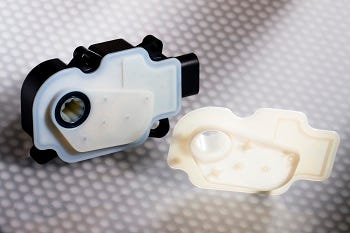Laser-weldable PBT contributes to fuel efficiency
A new innovation in radiator design relies on a novel control module that incorporates a laser-welded housing employing laser-transparent polybutylene terephthalate (PBT) resin supplied by BASF (Ludwigshafen, Germany).
July 25, 2012
A new innovation in radiator design relies on a novel control module that incorporates a laser-welded housing employing laser-transparent polybutylene terephthalate (PBT) resin supplied by BASF (Ludwigshafen, Germany).
|
Laser welding is employed in actuator cover manufacture. White component is laser-transparent PBT grade while black PBT/ASA material absorbs infrared laser light, generating heat for welding. |
In the future, it will be possible to control the air flow that cools modern car engines, achieving even greater efficiency than before: movable air flaps or vanes installed behind the radiator grill can be closed by the actuator in response to cold weather, helping the engine to reach its operating temperature more quickly. At the same time, the closed vanes reduce air resistance when the vehicle is travelling at high speeds, which also saves fuel.
Motor developer Precision Motors Deutsche Minebea (PM DM, Villingen-Schwenningen, Germany) worked with Röchling Automotive (Mannheim, Germany) to develop an air flap control unit for this very task. The compact actuator consisting of gears, an electric motor and an electronic unit serves to control the air flaps, thus contributing to better aerodynamics and lower CO2 emissions.
The highly laser-transparent PBT Ultradur LUX grade employed in the housing delivers stiffness and dimensional stability, even in damp environments, two properties which are particularly important in the electric and electronic realms. The product's key characteristic is its high transparency toward near-infrared light in the 800 to 1100 nm wavelength, precisely the crucial range for penetration laser welding. The improved transparency to laser light means that this material can be welded faster than other PBT grades available on the market according to BASF.
Moreover, the processing window is considerably wider and the risk of damage to the material is much lower. The grade used here, Ultradur LUX B4300 G4, is reinforced with 20% glass fiber. The laser-absorbing black part of the housing is made with Ultradur S 4090G4, a particularly low-warpage PBT/ASA compound."-[email protected]
About the Author(s)
You May Also Like



